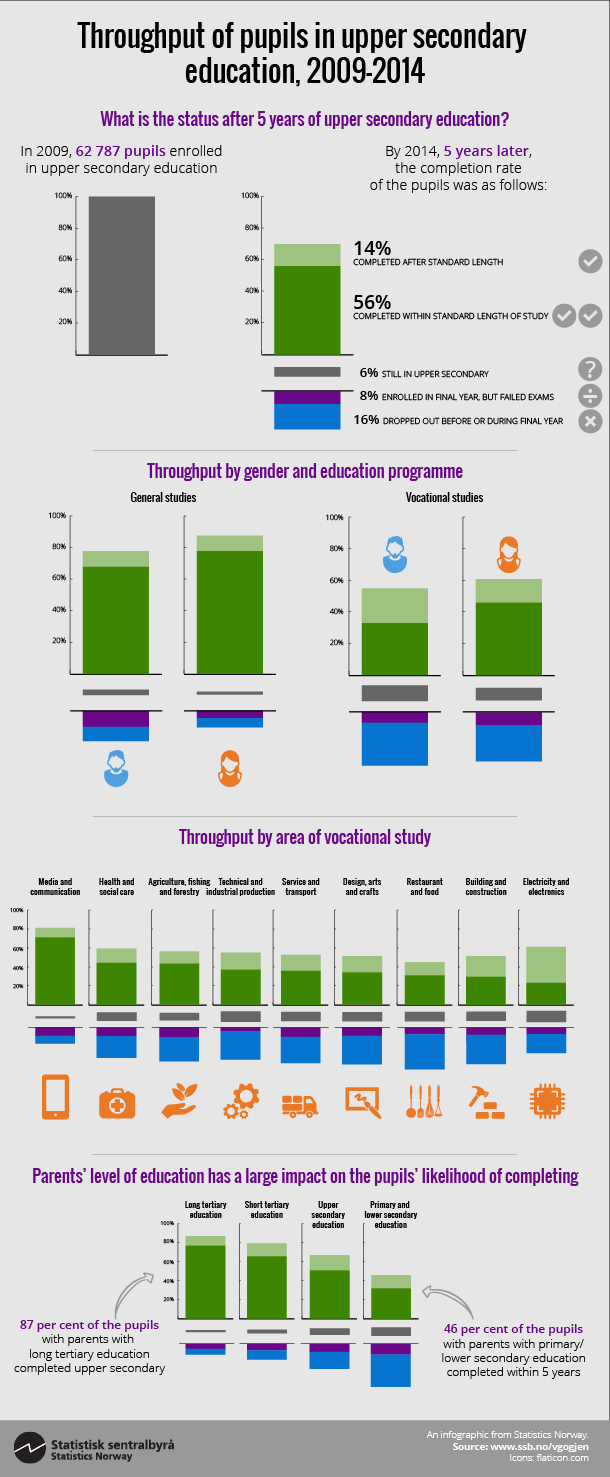Content
Published:
Updated:
This is an archived release.
Unchanged completion
The share of pupils who started upper secondary education for the first time in 2009 and achieved a university admission certification or professional competence within 5 years was unchanged from the 2008 class. More women than men completed their upper secondary education.
| 2009-2014 | Change in percentage points | |||
|---|---|---|---|---|
| Started a basic course | Share of pupils who have completed upper secondary education within five years | 2008-2013 - 2009-2014 | 1994-1999 - 2009-2014 | |
| Total | 62 787 | 71 | 0.2 | 2.3 |
| Males | 32 077 | 66 | -0.1 | 5.0 |
| Females | 30 710 | 76 | 0.4 | -0.5 |
| General studies | 32 130 | 83 | -0.3 | 0.9 |
| Males | 14 640 | 78 | -0.5 | -0.8 |
| Females | 17 490 | 87 | -0.1 | 2.3 |
| Vocational studies | 30 657 | 58 | 0.5 | 7.0 |
| Males | 17 437 | 56 | -0.1 | 13.7 |
| Females | 13 220 | 61 | 1.0 | -1.9 |
About 62 790 pupils started upper secondary education in 2009 for the first time. About 71 per cent of these pupils completed upper secondary school during a five-year period; the same share as for the 2008 class. About 68 per cent of the pupils who started upper secondary education in 1994 - when these statistics were introduced - achieved a university admission certification or professional competence within five years. The figure gives further details.
Higher share of women than men completed
About 76 per cent of women and 66 per cent of men who started upper secondary education in 2009 completed within five years; the same share as for the 2008 class.
Among the 29 per cent of the pupils who did not complete within 5 years, 16 per cent dropped out before their final year and 7 per cent did not achieve a university admission certification or professional competence. The rest, 6 per cent, were still in upper secondary education after 5 years.
Disparities in education programmes
Eighty-three per cent of the pupils started on general studies completed within 5 years. The corresponding percentage for vocational studies was 58 per cent. Both percentages were unchanged compared with the previous year’s class. Further details are given in the figure.
Social background is an important factor
Parents’ level of education has a large impact on the pupils’ likelihood of achieving a certificate. Eighty-seven per cent of the pupils have completed within 5 years when their parents have a long tertiary education. The corresponding figure was 46 per cent when the parents’ highest education level was lower secondary school. See figure.
High points from lower secondary school is important1
In the group of pupils with good marks; 55 school points or more, 99 per cent completed upper secondary education within five years. On the other hand, among pupils with less than 25 points, only 14 per cent completed.
1 Corrected 2 November 2015.
Additional information
Statistics follow an intake of pupils through a five-year period in upper secondary education.

